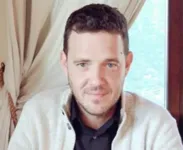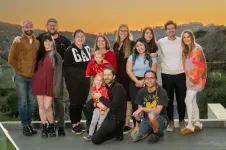(Press-News.org) Ice in nature is surrounded by liquid most of the time, and therefore it is key to understand how ice and liquid interact. A Kobe University and Institute for Molecular Science study could now for the first time directly observe the precise shape of ice at the interface between ice and liquid – by using antifreeze and a refrigerated microscope.
When we slide on ice, when snowflakes form, when we lick ice cream, the surface of the ice is always covered with liquid water, and understanding the interaction between the liquid water and the ice is vital to understanding the whole phenomenon. However, because ice and water quickly transform into each other, it has been impossible to directly observe the interface between the two.
To get closer to understanding how ice interacts with its surrounding liquid, researchers led by Kobe University’s ONISHI Hiroshi decided to try the next best thing. He says: “We came up with the idea of measuring ice immersed in antifreeze colder than 0°C. This way, the ice doesn’t melt and the interface doesn’t move, and it should be possible to make precise observations.” Even so, the researchers struggled to get good measurements of the ice. “Through various trial and error processes, we found that we had to cool the entire microscope system in a cooling box, and it took some ingenuity to ensure that the atomic force microscope, a precision measuring instrument, could operate stably at sub-zero temperatures,” explains the Kobe University researcher.
In The Journal of Chemical Physics, the group now published their results. They found that, while ice without surrounding liquid features so-called “frost pillars” about 20 nanometers tall, in antifreeze the ice is perfectly flat with occasional steps only one molecular layer high. “We think that the flat surface is formed through … partial dissolution and recrystallization of the ice surface in the 1-octanol liquid (the antifreeze),” the researchers write in the paper.
Onishi and his team also tried different liquids, all alcohols like 1-octanol. And even though all liquids they tried have similar properties, they observed that the ice surface looks different in each case, underscoring the importance of directly measuring the interface. In addition, they investigated the “hardness” of the ice surface under 1-octanol and found that the ice is much harder than previously estimated using less direct methods.
The researchers hope that their results will invite further study of the ice-liquid interface, but they have also set clear goals for their own future work saying: “We expect to increase the resolution of the microscope to single water molecules and use measurement methods other than atomic force microscopy. In this way, we hope to expand the range of possible applications of molecular-level measurements of the ice-antifreeze interface.”
This research was funded by the Ministry of Education, Culture, Sports, Science and Technology Japan (grants JPMXP1222MS0008 and JPMXP1223MS0001) and the Japan Society for the Promotion of Science (grants 21K18935 and 23H05448). It was conducted in collaboration with researchers from the Institute for Molecular Science, National Institutes of Natural Sciences.
Kobe University is a national university with roots dating back to the Kobe Commercial School founded in 1902. It is now one of Japan’s leading comprehensive research universities with nearly 16,000 students and nearly 1,700 faculty in 10 faculties and schools and 15 graduate schools. Combining the social and natural sciences to cultivate leaders with an interdisciplinary perspective, Kobe University creates knowledge and fosters innovation to address society’s challenges.
END
It takes a cool microscope and antifreeze to really look at ice
2024-07-09
ELSE PRESS RELEASES FROM THIS DATE:
First local extinction in the US due to sea level rise
2024-07-09
The United States has lost its only stand of the massive Key Largo tree cactus in what researchers believe is the first local extinction of a species caused by sea level rise in the country.
The Key Largo tree cactus (Pilosocereus millspaughii) still grows on a few scattered islands in the Caribbean, including northern Cuba and parts of the Bahamas. In the United States, it was restricted to a single population in the Florida Keys, first discovered in 1992 and monitored intermittently since.
Salt water intrusion from rising seas, soil depletion from hurricanes and high tides, and herbivory by mammals had put significant pressure ...
Empowering Ugandan female youth with self-esteem, self-efficacy, and gratitude using Transcendental Meditation
2024-07-09
A peer-reviewed study published today in Health Care for Women International found that the Transcendental Meditation® (TM®) technique can empower the lives of female youth living under conditions of poverty in the city slums of Kampala, Uganda. Outcomes include increased self-esteem, self-efficacy, and gratitude; and decreased tiredness, worry, and excessive alcohol use. TM helped these young women improve their mental and physical health, as well as their relations with family and community members.
“The ...
Brian Wachtel is promoted to Chief Development Officer at NFCR
2024-07-09
The National Foundation for Cancer Research (NFCR) proudly announces the promotion of Brian Wachtel to Chief Development Officer. Brian will continue his responsibilities as the Executive Director, and his expanded role will further enhance his leadership within the organization.
Brian joined the National Foundation for Cancer Research in September 2016 as the Director of Corporate Partnerships & Special Events. In that capacity, he was in charge of organizing and expanding NFCR’s community outreach events. One of his important ...
Digital self-harm surges among U.S. teens from 2016 to 2021
2024-07-09
Adolescents worldwide have embraced social media and online platforms for self-expression and to explore their identity. This freedom, however, can lead to risky behaviors, especially with limited adult supervision. For example, digital self-harm is a recent, emerging trend where individuals anonymously post or share hurtful content about themselves online. This behavior can be mistaken for mistreatment by others, yet the perpetrator and victim are the same person.
First identified in 2010, digital self-harm has not received the same amount of scholarly scrutiny as other forms of self-directed abuse and has not been widely addressed by adults ...
UTSA joins new consortium dedicated to nuclear security and nonproliferation
2024-07-09
The University of Texas at San Antonio (UTSA) has joined one of two newly established university consortia committed to nuclear security and nonproliferation. The consortia were awarded $50 million in cooperative agreements by the Office of Defense Nuclear Nonproliferation in the U.S. Department of Energy’s National Nuclear Security Administration (DOE NNSA).
“The pressing challenges of nuclear security and nonproliferation require a concerted effort from experts across the country,” said JoAnn Browning, UTSA interim vice president for research. ...
Diabetes increases the risk of failure in spinal fusion procedures
2024-07-09
A new study from orthopaedic researchers at The University of Toledo has found lumbar spinal fusion procedures are far more likely to fail in individuals with diabetes.
“We’ve known for a long time that diabetic patients are at high risk of infection from any surgery, including spinal fusion,” said Dr. Hossein Elgafy, a professor of orthopaedics in the College of Medicine and Life Sciences and chief of spine surgery at UTMC. “More recently, however, physicians have taken a closer look at the high ...
Brain-computer interface therapy for stroke survivors
2024-07-09
A personalized brain-computer interface therapy, RehabSwift, significantly enhances hand mobility for stroke survivors. Strokes often lead to impaired hand function, presenting substantial challenges in daily activities. Sam Darvishi and colleagues developed and tested a brain-computer interface therapy that translates imagined hand movements into real actions using a personalized algorithm and bionic hands. The study involved twelve chronic stroke survivors from South Australia who had limited use of their arms but retained clear thinking abilities. Throughout 18 sessions, participants used the RehabSwift system, which included a special cap that ...
SynGAP Research Fund (SRF) increases support for SYNGAP1 organoid research at the University of Southern California’s Quadrato Lab
2024-07-09
MILL VALLEY, Calif. – July 9, 2024 – SynGAP Research Fund (SRF), a 501(c)(3) public charity whose mission is to improve the quality of life for patients suffering from SYNGAP1-Related Disorders (SRD) through the research and development of treatments, therapies, and support systems, has awarded a $130,000 grant to the University of Southern California’s Quadrato Lab to inspect and stratify the effects of specific SYNGAP1 variants on their patient-derived neuronal model system, furthering the world’s understanding ...
Study finds 1 in 12 patients labeled as having ‘benign’ results actually had high-risk prostate cancer
2024-07-09
New research highlights the challenge of balancing the risks of overdiagnosing and underdiagnosing prostate cancer early enough to intervene and minimize risk of death. Recently, some experts have called for the lowest grade of prostate cancer—biopsy Gleason Grade Group (GGG) 1—to be reclassified as ‘benign.’ But a new study led by a researcher from Mass General Brigham has found that many patients with a biopsy GGG1 may have a more aggressive cancer than their biopsy alone suggests.
By looking at data from more than 10,000 patients at a university in Germany, researchers found that at least 8 percent of patients with this ...
Marcos Vilela wins Lilly Research Award for Doctoral Students
2024-07-09
The Royal Spanish Society of Chemistry (RSEQ) and Lilly have announced the winning theses of the 22nd Research Awards for Doctoral Students, which acknowledge outstanding work in the fields of Organic, Pharmaceutical, and Analytical Chemistry. Marcos Vilela, currently pursuing his PhD at the Center for Research in Biological Chemistry and Molecular Materials (CiQUS) at the University of Santiago de Compostela (USC), was awarded alongside Andrea Palone from the University of Girona (UdG) and the University of Rome "Tor Vergata," and Beatriz Arévalo from the Complutense University of Madrid (UCM).
Marcos' thesis, supervised by CiQUS Principal ...










